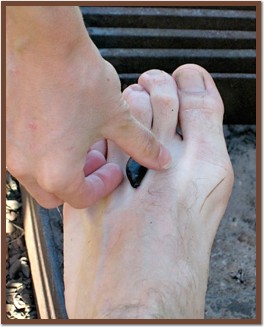
Leeches! |
By Doug Collicutt |

Plucking a leech off a foot. (Not my kid's foot!) Image by Bob Galindo, Wikimedia Commons.
"Eeyew, eeyew, eeyew . . . he's got a big leech on his leg!", spurted my wife as our eldest son emerged from the lake.
"Big whoop", I callously replied, "it's just a stupid leech".
The worst thing you can do when your kid encounters a leech or a tick or some other kind of nuisance critter is make a big deal about it. All that does is make the kid upset; kids are great at picking up on their parent's attitudes. That's how fear of snakes or insects is passed on from one generation to the next. (It's also how bigotry and racism move from generation to generation. Be careful what you teach your children.)
Now back to my kid with a leech on his leg. Instead of flipping out and trying to get the leech off right away I, once again, used the opportunity to teach my kids about yet another critter they have encountered in the wilds of Manitoba, one they would undoubtedly have to deal with many more times in their lives.
Leeches, or blood-suckers as they are often referred to, are very common in freshwater environments all around the world. And as anyone who's ever watched a Hollywood jungle movie will know, there are even many varieties that live in humid tropical forests. (They just don't rain down on you from the branches like they do in the movies.) And, although many of them do have a penchant for blood meals, a lot of them eat a variety of other things, too. (More on the biology of leeches on the next page.)
So, "come here", I said, and dutifully my son came over to me calmly. "Let's have a look."
"See", I said, "it's just a leech. He's trying to get a meal off you by sucking a little of your blood". The leech was firmly attached, my son had been in the water for some time. "Leeches are related to worms, see how it has little segments to its body. They have little suckers on either end that they use to hold themselves onto things. And at the head end they have small jaws that cut into your skin so they can draw out some blood. Blood is a great food for animals, lots of protein and nutrients in it ya know. They only have simple eyes, so they can just see movements and shapes. If you get close enough to one in the water it swims out and grabs hold of you."
And with that brief explanation I reached out, grasped the leech firmly and gently pulled it off my son's leg.
"Hey, that didn't even hurt", he exclaimed. We dabbed it with a clean tissue and applied a little antiseptic (always in the beach bag when you have little kids) to the tiny wound and that was that, crisis averted.
There are a number of folk remedies for removing leeches, including putting salt on the poor creature, or the even the risky practice (for the afflicted person) of touching a lighted cigarette to the leech to burn it off. But, like for so many pest situations, the best remedy is knowledge, so carry on and learn some more about leeches.
Carry on for the Biology of Leeches![]()
| You can help NatureNorth produce more great articles with a secure donation through PayPal. Our Google Adsense ads pay our server costs, but that's about it. To learn more follow this link: Support NatureNorth. Thank-you! | |
Return to: Fall Issue | NatureNorth Front page
